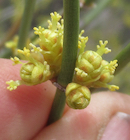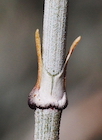Conservation Status

Ephedra aspera
Engelmann ex S. Watson 1883
Common names
Boundary ephedra, pitamoreal (Stevenson 1993).
Taxonomic notes
Syn: Ephedra peninsularis I.M. Johnston 1922; E. reedii Cory 1938; E. nevadensis S. Watson var. aspera (Engelmann ex S. Watson) L.D. Benson 1943 (Stevenson 1993).
Description
"Shrubs erect, 0.5-1.5 m. Bark gray, cracked and fissured. Branches opposite or whorled, rigid, angle of divergence about 30°. Twigs pale to dark green, becoming yellow with age, not viscid, slightly to strongly scabrous, with numerous longitudinal grooves; internodes 1-6 cm. Terminal buds conic, 1-2 mm, apex obtuse. Leaves opposite (rarely in whorls of 3), 1-3(-5) mm, connate to 1/2-7/8 their length; bases thickened, brown, shredding with age, ± persistent; apex obtuse. Pollen cones 2 (rarely 1 or whorled) at node, obovoid, 4-7 mm, sessile or rarely on short peduncles; bracts opposite, 6-10 pairs, yellow to red-brown, obovate, 3-4 × 2-3 mm, membranous; bracteoles slightly exceeding bracts; sporangiophores 4-5 mm, 1/2 exserted, with 4-6 sessile to short-stalked (less than 1 mm) microsporangia. Seed cones usually 2 at node, ovoid, 6-10 mm, sessile or on short, scaly peduncles; bracts opposite, 5-7 pairs, circular, 4-7 × 2-4 mm, membranous, with red-brown thickened center and base, margins entire. Seed 1, ellipsoid, 5-8 × 2-4 mm, light brown to brown, smooth to slightly scabrous. ... Coning March-April" (Stevenson 1993).
Stevenson (1993) provides this Key to the North American species of Ephedra.
Distribution and Ecology
US: Arizona, California, New Mexico, Texas; Mexico (northern); 500-1800 m on dry rocky slopes, ravines, and fans (Stevenson 1993).
Remarkable Specimens
No data as of 2023.03.03.
Ethnobotany
Observations
Remarks
The epithet aspera (Latin) means rough, a reference to the "very rough twigs" (Watson 1883).
Citations
Watson, Sereno. 1883. Contributions to American botany. 1. List of plants from southwestern Texas and northern Mexico, collected chiefly by Dr. E. Palmer in 1879-80. Proceedings of the American Academy of Arts and Sciences 18:96-191. Available: Biodiversity Heritage Library, accessed 2021.12.26.
See also
Species profile at Plants of the World Online, accessed 2021.12.29.




